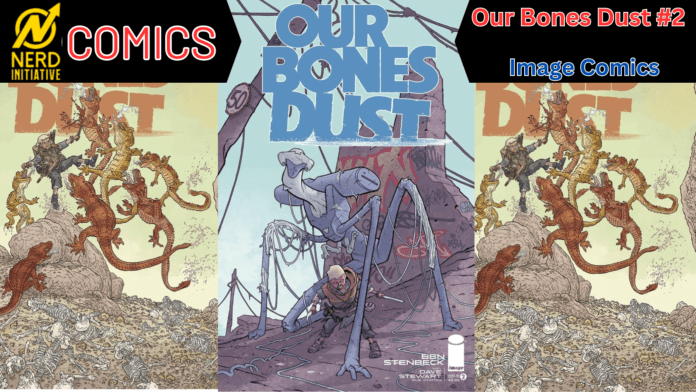Share this

Writer/Artist: Ben Stenbeck
Colorist: Dave Steward
Letterer: Rus Wooton
When it comes to storytelling, the key ingredient to making it work is empathy. You have to care about the plight being told otherwise the entire exercise is pointless. Typically, that investment comes from the characters’ plight, so what do you do when one of your main protagonists is not capable of saying a word? Well, with Ben Stenbeck’s Our Bones Dust that is exactly what is playing out.
I love watching creators place challenges in from of themselves and try to figure ways out. Even if it does not fully work it’s a fun exercise. With Our Bones Dust we have a world that is nearing the end if it’s not already there. Resources are beyond scarce and humans have devolved into small packs with limited language trying to kill whatever they can for food. One person trying to survive is a young juvenile boy who appears to be surviving on nothing more than animal instinct.
Overseeing this insanity is a group of aliens that are treating Earth the same way we treat the wreckage of a ship on the bottom of the ocean. They are trying to collect whatever data they can, and study the wildlife, but not interfere with natural order. Well, at least that’s the original plan. Attis, one of the alien creatures, has become concerned with the young feral boy to the point he may go beyond his prime objective due to the increasing danger around the child.
Any time you have a kid in danger there is inherent investment into that story. Unless you are a monster of course. Stenbeck enhances that attachment with the world he builds. This is a series where a lot goes unsaid. There’s not a mountain of exposition regarding what has brought the world to this point, but the aftermath speaks for itself. The corpse of a parent holding their child or a dog nearing starvation clues us into the harsh reality.
That’s all thanks to Stenbeck’s skill as a storyteller. He uses a very distinct line which helps highlight how barren this world is as nothing is visible beyond rock and dust. One of the best sequences involves the young child’s encounter with a family of lizards. A small moment that is executed so well to clue us into the heart of

this child.
Stenbeck has two of the best in the business with him as well as Dave Stewart and Rus Wooton are also on art duties. There’s not much dialog for Wooton to work with, but was a fan of his design of the alien radio communication balloon. It reminds me of a classic radio design to make the source of the communication clear. Stewart colors this world to be desolate and dusty as the title would indicate, but gives the alien a clean sheen to distiging for the turmoil.
My only struggle with this series is the lack of investment beyond the strong service-level design. The allegorical implications are certainly apparent. When humans begin to get tagged like we do sharks in the ocean the point is clear. It is simply not the strength of the narrative. When you start to throw around phrases like ‘Fake News’ you are traveling down well worn grown without much new from the commentary department.
Now it does not overtly detract from the otherwise positive experience of reading this series. It is simply not a strength, but it is also only issue two so it could develop into one before things end. For now, I am rather intrigued regarding what is being built here, just not fully invested yet.
3.5 / 5

